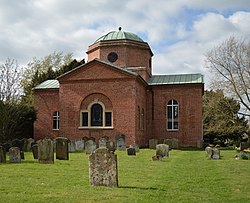Stratfield Saye
| Stratfield Saye | |
| Hampshire | |
|---|---|
 Church of St Mary the Virgin, Stratfield Saye | |
| Location | |
| Grid reference: | SU683617 |
| Location: | 51°21’1"N, 1°1’11"W |
| Data | |
| Postcode: | RG7 |
| Local Government | |
| Council: | Basingstoke and Deane |
Stratfield Saye is a small village in the north of Hampshire. The parish includes the hamlets of West End Green, Fair Oak Green and Fair Cross.
The suffice of the village's name shows is from the Saye family who owned the manor in the Middle Ages. "Stratfield" indicates a street or in this case the Roman road known as the Devil's Highway, the Roman road from London to Calleva Atrebatum (Silchester) which forms the northern parish boundary. Some older sources use the alternative spelling Strathfieldsaye, Stratford Saye, and Stratford Sea.[1]
Stratfield Saye House was built around 1630 as the Pitt family home, from fortunes made by Thomas "Diamond" Pitt. In the late 18th century the family were closely related to the Prime Ministers, William Pitt the Elder and William Pitt the Younger. It has been the home of the Dukes of Wellington since 1817.
The church
The parish church, near Stratfiedl Saye House, is an unusual domed Georgian]] building with the plan of a Greek Cross. It contains memorials to the Barons Rivers]] and to most of the Dukes of Wellington. The famous First Duke of Wellington lies in St Paul's Cathedral in London, but his funerary hatchment may be seen in St Mary's.
James Gerald Joyce (1819-78) was rector here from 1855 until his death. His interests were in archaeology and he led excavations at Calleva Atrebatum where he discovered the Silchester eagle in 1866.[2] His wife Ellen Joyce was notable for her support of women emigrating to the empire.[3]
Outside links
| ("Wikimedia Commons" has material about Stratfield Saye) |
References
- ↑ "Brewer's Dictionary of Phrase and Fable". 1898. http://www.bartleby.com/81/13097.html. Retrieved 2008-04-26.
- ↑ "Silchester Gallery" (in en). 2017-04-03. https://www.readingmuseum.org.uk/your-visit/permanent-galleries/silchester-gallery.
- ↑ "Joyce [née Rice, Ellen (1832–1924), organizer of women's emigration"] (in en). doi:10.1093/ref:odnb/74348. https://www.oxforddnb.com/view/10.1093/ref:odnb/9780198614128.001.0001/odnb-9780198614128-e-74348;jsessionid=85733D237268236527626C627AC72263.
